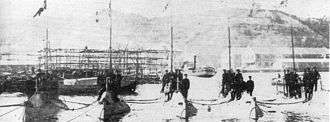Japanese Type 1 submarine
 Holland 1 Class Submarine purchased during the Russo Japanese War | |
| Class overview | |
|---|---|
| Builders: | Fore River Shipbuilding, Quincy, Massachusetts, USA |
| Operators: |
|
| Preceded by: | none |
| Succeeded by: | Kaigun Type 6 |
| In commission: | 1905–1921 |
| Completed: | 5 |
| Retired: | 5 |
| General characteristics | |
| Type: | Submarine |
| Displacement: |
|
| Length: | 20.42 m (67.0 ft) |
| Beam: | 3.63 m (11.9 ft) |
| Draft: | 3.12 m (10.2 ft) |
| Installed power: |
|
| Propulsion: |
|
| Speed: |
|
| Range: |
|
| Test depth: | 45.7 metres (150 ft) |
| Complement: | 16 officers and enlisted |
| Armament: | 2 × 18 in (460 mm) bow torpedo tubes (2 × torpedoes) |

The No.1-class submarine (第一型潜水艦 Daiichi-gata sensuikan) was the first class submarines of the Imperial Japanese Navy. Consisting of five vessels, these submarines were modified Holland-class vessels built in the United States.
Background
The Japanese government was aware that the Imperial Russian Navy had obtained the Fulton, a prototype of the United States A-class or Plunger class in 1904 and had ordered an additional six vessels, designed by the Electric Boat Company and built in Russia under an 1904 emergency budget for use in the Russo-Japanese War. These vessels, known as the Som-class, were assembled in St. Petersburg and were designed to be transportable by train.[1]
In order to counter this threat to naval operations against the Russian Pacific Fleet, the Imperial Japanese Navy also made a contract with the Electric Boat Company and its Fore River Shipyard subcontractor for the construction of five Type VII submarines, a more advanced design than the Russian version, which had been developed in Lewis Nixon's Crescent Shipyard in an unsuccessful bid for the US Navy’s United States B class submarine contract.
Construction and operational history
These vessels were built at the Fore River Shipyard in Quincy, Massachusetts from August–October 1904.[2] Arthur Leopold Busch oversaw construction of the vessels, their dismantling, transport to Seattle by rail, shipment to Yokohama and reassembly at the Yokosuka Naval Arsenal in Yokosuka, Japan.[3] The project was done in complete secrecy, as the United States was officially neutral in the Russo-Japanese War.
The vessels arrived on 12 December 1904 in sections at the Yokahama dockyards. The entire project was completed in twelve months and were fully assembled and ready for combat operations by August 1905.[2]Frank Taylor Cable, an electrician who was working for Isaac Rice's Electro-Dynamic and Electric Storage Battery Companies along with Rice's Electric Boat, arrived some six months after Busch, training the Imperial Japanese Navy in the operation of the newly introduced submarines. However, hostilities with Russia were nearing its end by that date, and no submarines saw action during the war. Busch was honored with the Order of the Rising Sun, 4th class by Emperor Meiji for his efforts.[4] These submarines were used primarily for training duties. Submarine No-4 sank at Kure in a gasoline explosion on 14 November 1916, but was raised, repaired and placed back into service.
Ships in class
- Japanese submarine No-1 (第一潜水艇 Dai-ichi sensuikan), laid down 30 November 1904; launched 20 March 1905; commissioned 31 July 1905; reclassified as 2nd class submersible on 4 August 1916, reclassified as 3rd class submarine on 1 April 1919; decommissioned on 30 April 1921.[5]
- Japanese submarine No-2 (第二潜水艇 Dai-ni sensuikan), laid down 1 December 1904; launched 2 May 1905; commissioned 5 September 1905; reclassified as 2nd class submersible on 4 August 1916, reclassified as 3rd class submarine on 1 April 1919; decommissioned on 30 April 1921.[5]
- Japanese submarine No-3 (第三潜水艇 Dai-san sensuikan), laid down 30 November 1904; launched 16 May 1905; commissioned 5 September 1905; reclassified as 2nd class submersible on 4 August 1916, reclassified as 3rd class submarine on 1 April 1919; decommissioned on 1 April 1921.[5]
- Japanese submarine No-4 (第四潜水艇 Dai-yon sensuikan), laid down 4 December 1904; launched 27 May 1905; commissioned 1 October 1905; reclassified as 2nd class submersible on 4 August 1916, reclassified as 3rd class submarine on 1 April 1919; decommissioned on 1 April 1921.[5]
- Japanese submarine No-5 (第五潜水艇 Dai-go sensuikan), laid down 30 November 1904; launched 13 May 1905; commissioned 1 October 1905; reclassified as 2nd class submersible on 4 August 1916, reclassified as 3rd class submarine on 1 April 1919; decommissioned on 1 April 1921.[5]
References
- Gardiner, Robert (1985). Conway's All the World's Fighting Ships, 1906–1921. Naval Institute Press. ISBN 0-87021-907-3.
- Evans, David C.; Peattie, Mark R. (1997). Kaigun: Strategy, Tactics, and Technology in the Imperial Japanese Navy, 1887-1941. Annapolis, MD: Naval Institute Press. ISBN 0-87021-192-7.
- Howarth, Stephen (1983). The Fighting Ships of the Rising Sun: The Drama of the Imperial Japanese Navy, 1895-1945. Atheneum. ISBN 0-689-11402-8.
- Jentsura, Hansgeorg (1976). Warships of the Imperial Japanese Navy, 1869-1945. Annapolis, MD: Naval Institute Press. ISBN 0-87021-893-X.
- Roberts, John (ed). (1983). 'Warships of the world from 1860 to 1905 - Volume 2: United States, Japan and Russia. Bernard & Graefe Verlag, Koblenz. ISBN 3-7637-5403-2.
- Schencking, J. Charles (2005). Making Waves: Politics, Propaganda, And The Emergence Of The Imperial Japanese Navy, 1868-1922. Stanford University Press. ISBN 0-8047-4977-9.
External links
- Nishida, Hiroshi. "Materials of IJN". Imperial Japanese Navy.